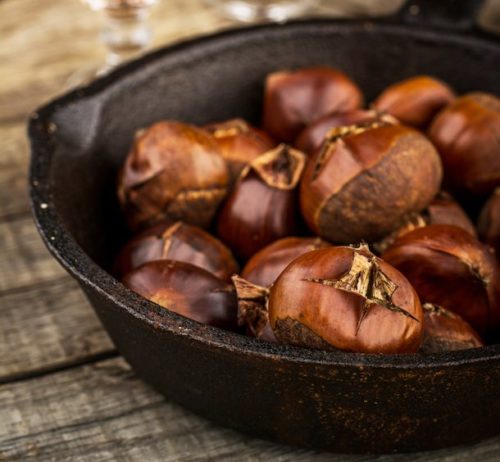5 Vintage (and Delicious) Chestnut Recipes

Thirty-four years before “Old King Cole” lent his velvety voice to a hoary old chestnut, a chef in 1912 wrote on the economy of the Castanea and presented five vegetarian dishes, offering the neglected nut a starring role at the American table.
The Chestnut in the Recipe: A Rich and Delicious Vegetable Substitute
Originally published in The Country Gentleman, November 8, 1912
The American people are far behind the European peasantry in the use of nuts in the daily menu. In Southern Europe and Western Asia the chestnut forms a large part of the food of the poor. It is used fresh, roasted, boiled, and so forth, and the dried nuts are ground into meal or flour and made into very nutritious bread and other articles of food.
Donate to or volunteer with the American Chestnut Foundation, committed to restoring the American chestnut tree in the Appalachian hardwood forest.
Unlike most nuts, the chestnut contains a large percentage of starch, and in a raw state is somewhat difficult of digestion, but cooked chestnuts are easily assimilated. They are the least oily of the nuts and may be used in many ways on the table. Chestnuts are the “macrons” of the French, who use them in a variety of ways. The European chestnut, variously called French, Spanish, or Italian, is larger than the American sweet chestnut and therefore easily prepared, but it is not so finely flavored.
Chestnut (Spanish) Soup
Allow about a pound of unshelled nuts to a quart of soup. Boil the nuts for five minutes, drain, and remove the shells and skins. To three-fourths of a pound of the meats, add one quart of water and let boil for about three-quarters of an hour, or until they are soft. Rub through a sieve and return to the fire in the water in which they were stewed, season to taste with salt, mace and cayenne, and add half a cupful of sweet cream.
Boiled Chestnuts
These are a delicious substitute for potatoes. Wash the nuts well, make an incision in the shell of each, boil in salted water until quite soft, then drain and peel, removing the inner skin, and serve hot.
Chestnut Roast
Boil one pound of chestnuts until tender, remove the shells, add one teaspoonful of salt, a pinch of thyme, and mix thoroughly. Boil together one large turnip, one carrot, two large potatoes, two stalks of celery, three peppercorns and two cloves. When the vegetables are tender, drain, add the chestnuts, and mash all together, adding two tablespoonfuls each of butter and cream. Salt to taste, put in a well- buttered mold in a hot oven and heat thoroughly. Serve on a platter, garnishing with slices of lemon and sprigs of parsley.

Mashed Chestnuts
Take forty or fifty of the large French chestnuts, shell them, pour boiling water over and let stand for ten minutes, then remove the brown skin. Cover with salted boiling water and cook until soft enough to mash. Season with a tablespoonful of butter, salt and pepper to taste, mash and mix well, adding a little cream to moisten. Then press through a potato-ricer in a light, feathery heap on a hot plate and serve at once. Or they may be mashed smooth and then beaten until light, and piled lightly on the plate from which they are to be served.
Deviled Chestnuts
Roast chestnuts until tender, remove the shells and skin, sauté in hot butter, sprinkling with salt and paprika or a dash of red pepper. Serve at once, with cheese.
[21st-century tip: To roast chestnuts, preheat oven to 425°F. Rinse nuts. Make an X-shaped incision across each husk (just grazing the meat) — this allows steam to escape while the chestnut cooks. Place nuts into a rimmed baking dish and heat in the oven for about 15 minutes, or until the husk begins to curl away from meat. Cool and peel.]